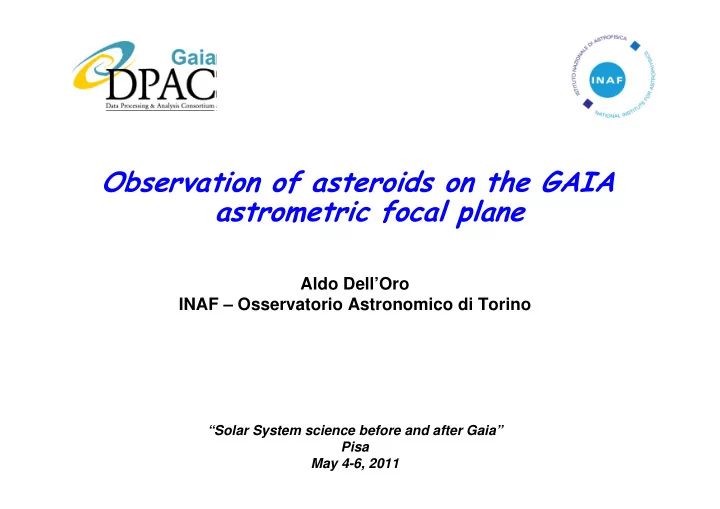

Observation of asteroids on the GAIA astrometric focal plane Aldo Dell’Oro INAF – Osservatorio Astronomico di Torino “Solar System science before and after Gaia” Pisa May 4-6, 2011
Along-scan direction (AL) Across-scan direction (AC)
How does the instrument work? CCD AC window AL CCD matrix is 4500 pixels AL and 1966 pixels AC. Only a small window of pixels around each source is read-out and transmitted. The size of the window depends on the magnitude of the source. Generally the window is 6 or 12 pixels wide in the AL scan direction.
How does the instrument work? Read-out register CCD AL sample final edge pixel line window
How does the instrument work? Read-out register CCD AL window Time Delay Integration (TDI) mode: charge transfer pixel to pixel following the AL motion of the signal (for fixed stars)
How does the instrument work? Read-out register CCD AL window Time Delay Integration (TDI) mode: charge transfer pixel to pixel following the AL motion of the signal (for fixed stars)
How does the instrument work? Read-out register CCD AL window Number of collected photo-electrons in each window sample (ADUs)
AL direction Final transmitted signal
Final transmitted signal: astrometry orbit orbit determination determination Astrometric Astrometric centroid reduction centroid reduction ( α, δ ) ( α, δ ) determination determination
Final transmitted signal: photometry photometric Inversion: photometric Inversion: shapes and spins shapes and spins G-band flux G-band flux magnitude determination magnitude determination
PSF ( f) PSF ( f) im age ( g) im age ( g) ∗ convolution convolution signal ( g* f) signal ( g* f) signal form ation for extended sources ( asteroids)
PSF ( f) im age ( g = δ ) PSF ( f) im age ( g = δ ) ∗ convolution convolution signal ( g* f) = f signal ( g* f) = f signal form ation for point-like sources ( stars)
point-like extended source source ( ∅ = 3 pixels) : • How m uch is it different from a PSF signal? • Can the angular size be m easured?
AC motion AL AL delay window (TDI) motion AL motion
extended & m oving extended source source ( ∼ 1 0 0 m as/ sec) : ( ∅ = 3 pixels) Additional signal spread: “extra-size” in apparent angular extension
extended & m oving extended source source ( delay of 3 pixels) : ( ∅ = 3 pixels) Not TDI -synchronized m otion: shift of the centroid position
Centroids’ delays and motion determination AF1 centroid
Centroids’ delays and motion determination AF1 centroid AF3 centroid
Centroids’ delays and motion determination AF1 centroid AF3 centroid AF5 centroid
Centroids’ delays and motion determination AF1 centroid AF3 centroid AF5 centroid AF7 centroid
Centroids’ delays and motion determination AF1 centroid AF3 centroid AL motion AF5 centroid determination AF7 centroid AF9 centroid Correction of the extra-size due to motion
Optical im age form ation Scattering Law (Reflection Coefficient, or Bidirectional Reflectance Distribution illumination shape, size, Function) conditions orientation apparent source photometric distribution ( L )
photo-center centroid bary-center photo-center shift correction
Radiation damage CCD electronic traps Interplanetary radiation environment includes high- energy extra-solar cosmic rays, but the particle fluence is dominated by lower energy solar protons from solar flares (Gaia’s launch is planned around the next solar maximum). Energetic particles can cause an electronic damage of the CCDs, producing the formation of “traps” for the photoelectrons. pixel
Regular charge transfer photoelectrons
Regular charge transfer
Regular charge transfer
Charge transfer inefficiency (CTI) photoelectrons
Charge transfer inefficiency (CTI)
Charge transfer inefficiency (CTI) captured photoelectrons
Charge transfer inefficiency (CTI)
Charge transfer inefficiency (CTI) released photoelectrons
Charge transfer inefficiency (CTI)
CTI: effect on centroid and magnitude signal affected by CTI signal without CTI flux bias AL direction Signal distortion depends on source flux and traps population (the CCD history). Traps population parameters can be calibrated during the mission. A mitigation strategy to reduce CTI is adopted using artificial charge injections in order to centroid bias “reset” the traps occupancies.
Conclusions GAIA will provide an important opportunity to obtain a large amount of homogeneous astrometric and photometric data about asteroids. The prospect of the final data is excellent: mass measurement for ∼ 100 asteroids, size for ∼ 1000 objects, and shape & rotational properties for tens of thousands asteroids. Nevertheless, extraction of information about positions, fluxes and angular size of those sources requires a careful analysis of the signal from the astrometric CCDs. Unlike fixed stars, for which the instrument is conceived specifically, asteroids require a procedure of analysis apart on account of their motion and apparent angular extension . Potential critical problems can rise from the lack of information for each detected asteroid about the reflectance properties of the surface (impacting on size determination and photo-center shift correction), and from the disturb introduced by the CCD charge transfer inefficiency that can be particularly tricky to treat for extended moving sources.
http://www.rssd.esa.int/Gaia
Recommend
More recommend